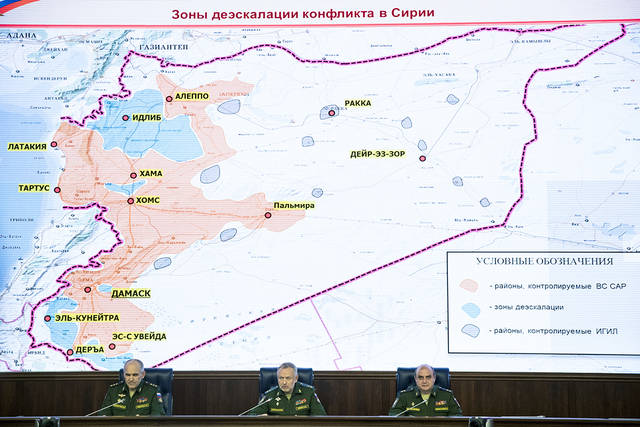BEIRUT — A deal hammered out by Russia, Turkey and Iran to set up “de-escalation zones” in mostly opposition-held parts of Syria went into effect in the early hours of Saturday. ADVERTISING BEIRUT — A deal hammered out by Russia,
BEIRUT — A deal hammered out by Russia, Turkey and Iran to set up “de-escalation zones” in mostly opposition-held parts of Syria went into effect in the early hours of Saturday.
The plan is the latest international attempt to reduce violence in the war-ravaged country, and is the first to envisage armed foreign monitors on the ground in Syria. The United States is not party to the agreement and the Syrian rivals have not signed on to the deal. The armed opposition, instead, was highly critical of the proposal, saying it lacks legitimacy.
The plan, details of which will still be worked out over the next several weeks, went into effect at midnight Friday. There were limited reports of bombing in northern Homs and Hama, two areas expected to be part of the “de-escalation zones,” activists said. There were no immediate reports of casualties.
It is not clear how the cease-fire or “de-escalation zones” will be enforced in areas still to be determined in maps to emerge a month from now.
Russian officials said it will be at least another month until the details are worked out and the safe areas established.
In the tangled mess that constitutes Syria’s battlefields, there is much that can go wrong with the plan, agreed on in talks Thursday in Kazakhstan.
There is no clear mechanism to resolve conflict and violations— like most other previous deals struck by backers of the warring sides.
A potential complication to implementing the plan is the crowded airspace over Syria. The deal calls for all aircraft to be banned from flying over the safe zones.
Syrian, Russian, Turkish and U.S.-led coalition aircraft operate in different, sometimes same areas in Syria. It is not yet clear how the new plan would affect flightpaths of U.S.-led coalition warplanes battling Islamic State militants and other radical groups — and whether the American air force would abide by a diminished air space.
Russia and Iran — two of the plan’s three sponsors — are key allies of President Bashar Assad’s government and both are viewed as foreign occupation forces by his opponents. Rebels fighting to topple Assad are enraged by Iran’s role in the deal and blame the Shiite power for fueling the sectarian nature of Syria’s conflict, now in its seventh year.
Turkey, the third sponsor, is a major backer of opposition factions and has also sent troops into northern Syria, drawing the ire of Assad and his government.
Yet troops from the three countries are now expected to secure four safe zones. An official with Russia’s military general staff said other countries may eventually have a role in enforcing the de-escalation areas.



